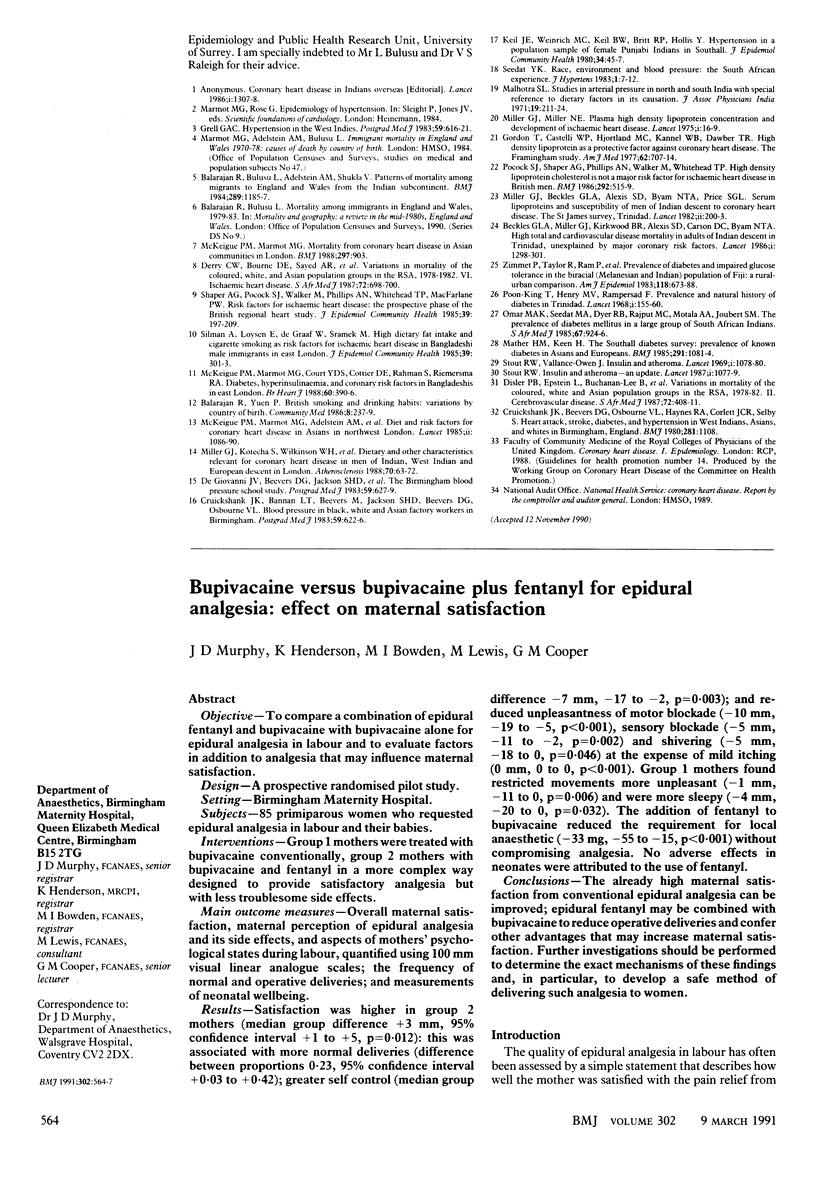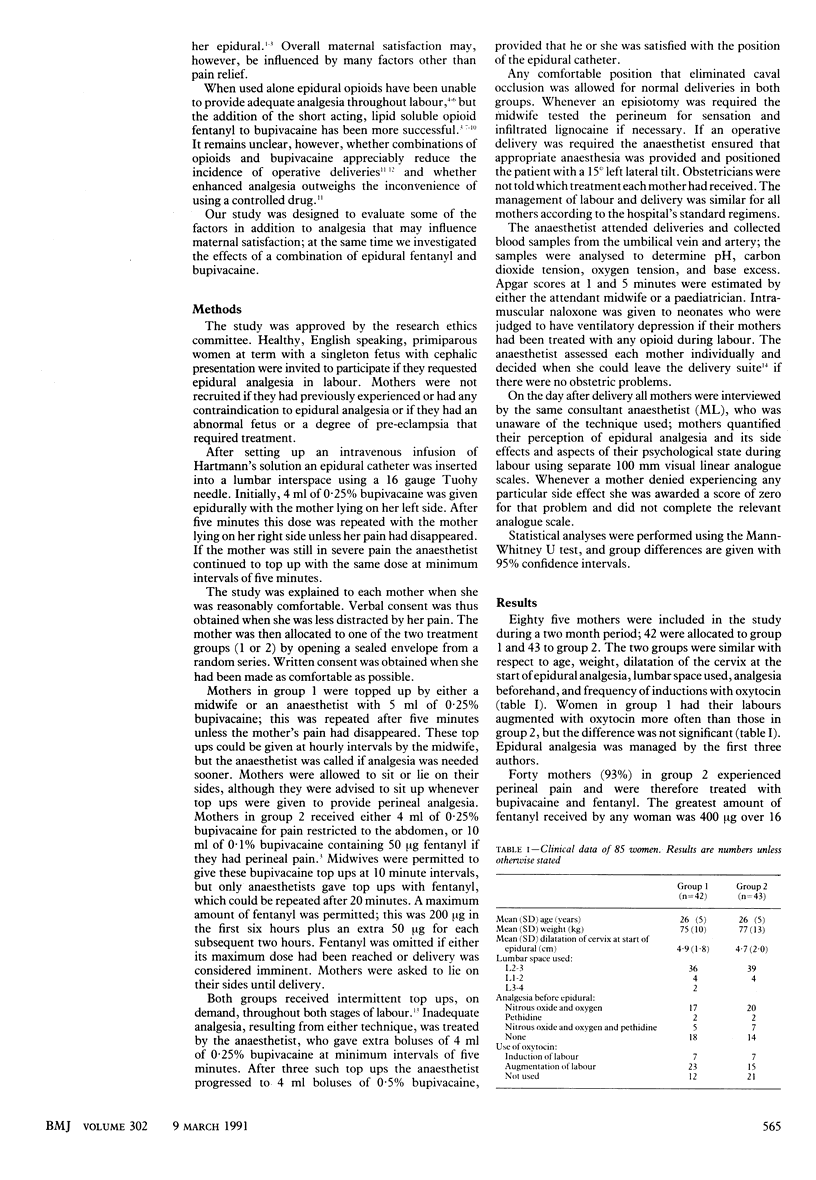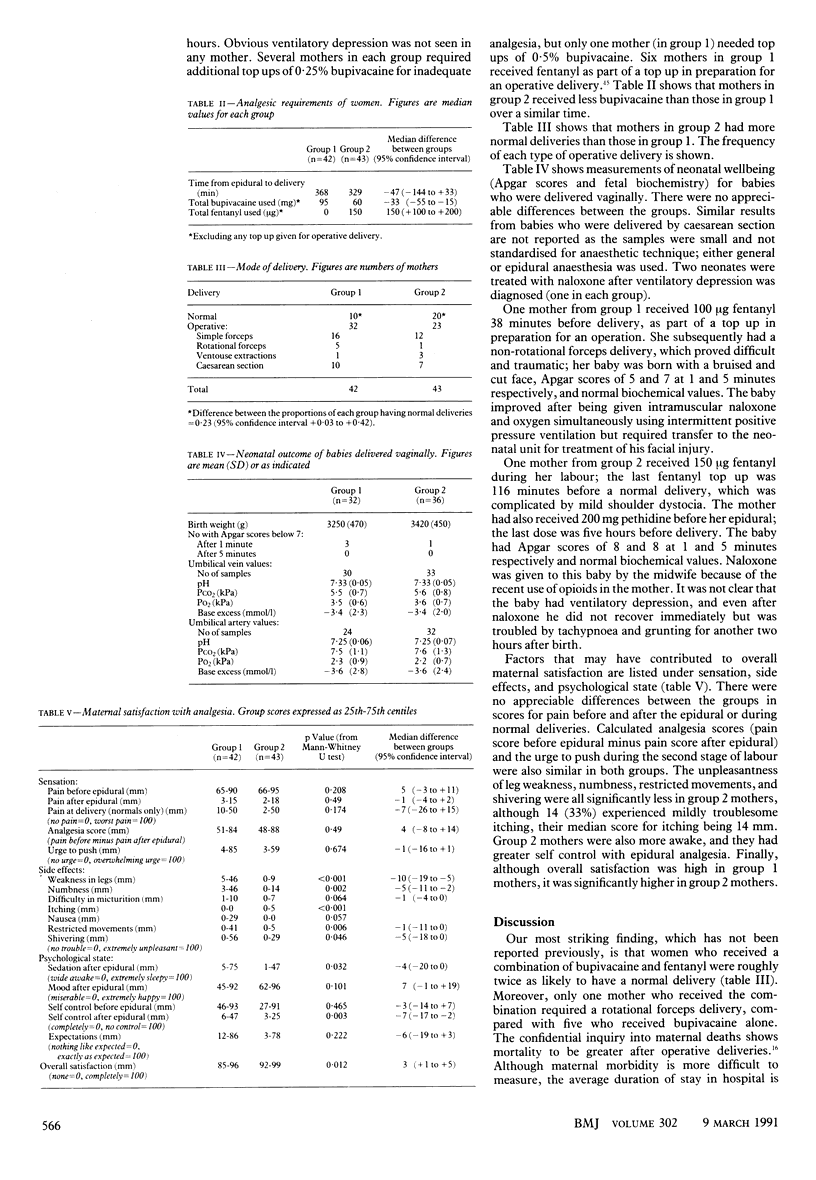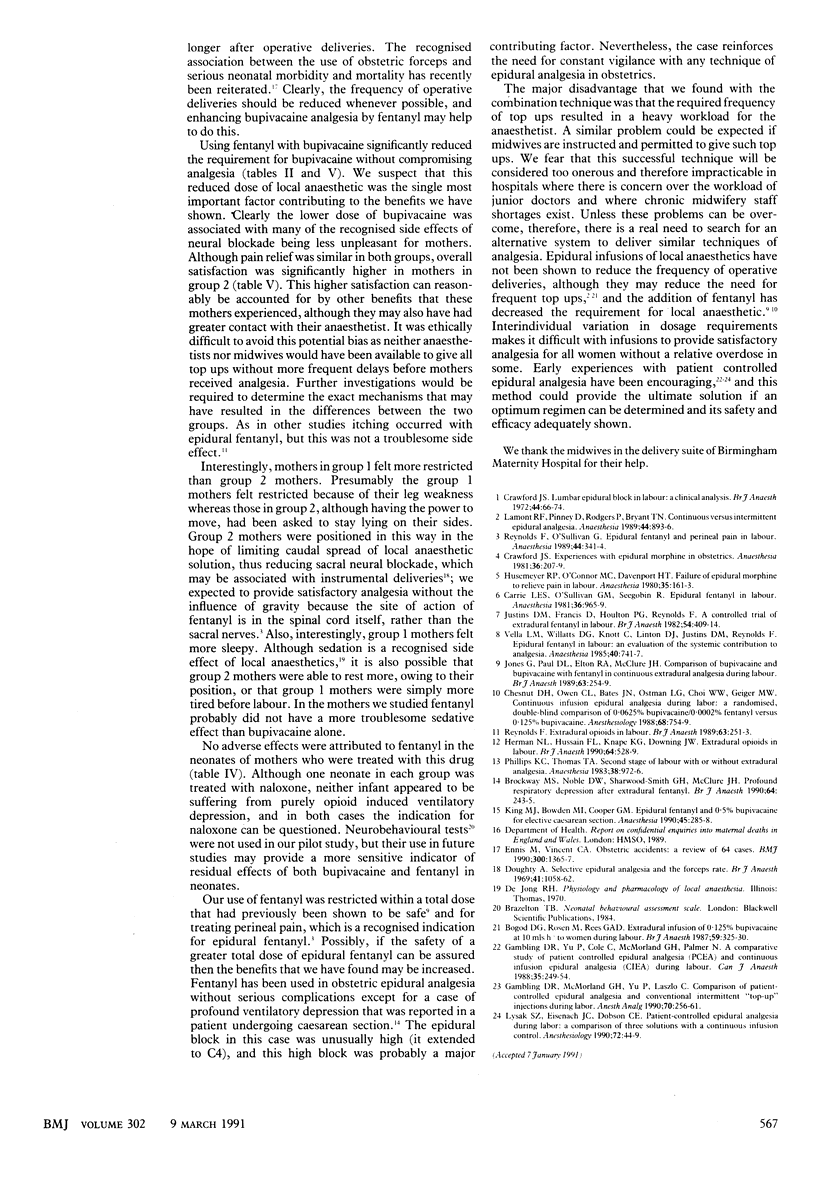Abstract
OBJECTIVE--To compare a combination of epidural fentanyl and bupivacaine with bupivacaine alone for epidural analgesia in labour and to evaluate factors in addition to analgesia that may influence maternal satisfaction. DESIGN--A prospective randomised pilot study. SETTING--Birmingham Maternity Hospital. SUBJECTS--85 primiparous women who requested epidural analgesia in labour and their babies. INTERVENTIONS--Group 1 mothers were treated with bupivacaine conventionally, group 2 mothers with bupivacaine and fentanyl in a more complex way designed to provide satisfactory analgesia but with less troublesome side effects. MAIN OUTCOME MEASURES--Overall maternal satisfaction, maternal perception of epidural analgesia and its side effects, and aspects of mothers' psychological states during labour, quantified using 100 mm visual linear analogue scales; the frequency of normal and operative deliveries; and measurements of neonatal wellbeing. RESULTS--Satisfaction was higher in group 2 mothers (median group difference +3 mm, 95% confidence interval +1 to +5, p = 0.012): this was associated with more normal deliveries (difference between proportions 0.23, 95% confidence interval +0.03 to +0.42); greater self control (median group difference -7 mm, -17 to -2, p = 0.003); and reduced unpleasantness of motor blockade (-10 mm, -19 to -5, p less than 0.001), sensory blockade (-5 mm, -11 to -2, p = 0.002) and shivering (-5 mm, -18 to 0, p = 0.046) at the expense of mild itching (0 mm, 0 to 0, p less than 0.001). Group 1 mothers found restricted movements more unpleasant (-1 mm, -11 to 0, p = 0.006) and were more sleepy (-4 mm, -20 to 0, p = 0.032). The addition of fentanyl to bupivacaine reduced the requirement for local anaesthetic (-33 mg, -55 to -15, p less than 0.001) without compromising analgesia. No adverse effects in neonates were attributed to the use of fentanyl. CONCLUSIONS--The already high maternal satisfaction from conventional epidural analgesia can be improved; epidural fentanyl may be combined with bupivacaine to reduce operative deliveries and confer other advantages that may increase maternal satisfaction. Further investigations should be performed to determine the exact mechanisms of these findings and, in particular, to develop a safe method of delivering such analgesia to women.
Full text
PDF



Selected References
These references are in PubMed. This may not be the complete list of references from this article.
- Bogod D. G., Rosen M., Rees G. A. Extradural infusion of 0.125% bupivacaine at 10 ml h-1 to women during labour. Br J Anaesth. 1987 Mar;59(3):325–330. doi: 10.1093/bja/59.3.325. [DOI] [PubMed] [Google Scholar]
- Brockway M. S., Noble D. W., Sharwood-Smith G. H., McClure J. H. Profound respiratory depression after extradural fentanyl. Br J Anaesth. 1990 Feb;64(2):243–245. doi: 10.1093/bja/64.2.243. [DOI] [PubMed] [Google Scholar]
- Carrie L. E., O'Sullivan G. M., Seegobin R. Epidural fentanyl in labour. Anaesthesia. 1981 Oct;36(10):965–969. doi: 10.1111/j.1365-2044.1981.tb08658.x. [DOI] [PubMed] [Google Scholar]
- Chestnut D. H., Owen C. L., Bates J. N., Ostman L. G., Choi W. W., Geiger M. W. Continuous infusion epidural analgesia during labor: a randomized, double-blind comparison of 0.0625% bupivacaine/0.0002% fentanyl versus 0.125% bupivacaine. Anesthesiology. 1988 May;68(5):754–759. [PubMed] [Google Scholar]
- Crawford J. S. Lumbar epidural block in labour: a clinical analysis. Br J Anaesth. 1972 Jan;44(1):66–74. doi: 10.1093/bja/44.1.66. [DOI] [PubMed] [Google Scholar]
- Ennis M., Vincent C. A. Obstetric accidents: a review of 64 cases. BMJ. 1990 May 26;300(6736):1365–1367. doi: 10.1136/bmj.300.6736.1365. [DOI] [PMC free article] [PubMed] [Google Scholar]
- Gambling D. R., McMorland G. H., Yu P., Laszlo C. Comparison of patient-controlled epidural analgesia and conventional intermittent "top-up" injections during labor. Anesth Analg. 1990 Mar;70(3):256–261. doi: 10.1213/00000539-199003000-00005. [DOI] [PubMed] [Google Scholar]
- Gambling D. R., Yu P., Cole C., McMorland G. H., Palmer L. A comparative study of patient controlled epidural analgesia (PCEA) and continuous infusion epidural analgesia (CIEA) during labour. Can J Anaesth. 1988 May;35(3 ):249–254. doi: 10.1007/BF03010618. [DOI] [PubMed] [Google Scholar]
- Herman N. L., Hussain F. L., Knape K. G., Downing J. W. Extradural opioids in labour. Br J Anaesth. 1990 Apr;64(4):528–529. doi: 10.1093/bja/64.4.528-b. [DOI] [PubMed] [Google Scholar]
- Husemeyer R. P., O'Connor M. C., Davenport H. T. Failure of epidural morphine to relieve pain in labour. Anaesthesia. 1980 Feb;35(2):161–163. doi: 10.1111/j.1365-2044.1980.tb03797.x. [DOI] [PubMed] [Google Scholar]
- Jones G., Paul D. L., Elton R. A., McClure J. H. Comparison of bupivacaine and bupivacaine with fentanyl in continuous extradural analgesia during labour. Br J Anaesth. 1989 Sep;63(3):254–259. doi: 10.1093/bja/63.3.254. [DOI] [PubMed] [Google Scholar]
- Justins D. M., Francis D., Houlton P. G., Reynolds F. A controlled trial of extradural fentanyl in labour. Br J Anaesth. 1982 Apr;54(4):409–414. doi: 10.1093/bja/54.4.409. [DOI] [PubMed] [Google Scholar]
- King M. J., Bowden M. I., Cooper G. M. Epidural fentanyl and 0.5% bupivacaine for elective caesarean section. Anaesthesia. 1990 Apr;45(4):285–288. doi: 10.1111/j.1365-2044.1990.tb14733.x. [DOI] [PubMed] [Google Scholar]
- Lamont R. F., Pinney D., Rodgers P., Bryant T. N. Continuous versus intermittent epidural analgesia. A randomised trial to observe obstetric outcome. Anaesthesia. 1989 Nov;44(11):893–896. doi: 10.1111/j.1365-2044.1989.tb09142.x. [DOI] [PubMed] [Google Scholar]
- Lysak S. Z., Eisenach J. C., Dobson C. E., 2nd Patient-controlled epidural analgesia during labor: a comparison of three solutions with a continuous infusion control. Anesthesiology. 1990 Jan;72(1):44–49. doi: 10.1097/00000542-199001000-00009. [DOI] [PubMed] [Google Scholar]
- Phillips K. C., Thomas T. A. Second stage of labour with or without extradural analgesia. Anaesthesia. 1983 Oct;38(10):972–976. doi: 10.1111/j.1365-2044.1983.tb12028.x. [DOI] [PubMed] [Google Scholar]
- Reynolds F. Extradural opioids in labour. Br J Anaesth. 1989 Sep;63(3):251–253. doi: 10.1093/bja/63.3.251. [DOI] [PubMed] [Google Scholar]
- Reynolds F., O'Sullivan G. Epidural fentanyl and perineal pain in labour. Anaesthesia. 1989 Apr;44(4):341–344. doi: 10.1111/j.1365-2044.1989.tb11292.x. [DOI] [PubMed] [Google Scholar]
- Vella L. M., Willatts D. G., Knott C., Lintin D. J., Justins D. M., Reynolds F. Epidural fentanyl in labour. An evaluation of the systemic contribution to analgesia. Anaesthesia. 1985 Aug;40(8):741–747. doi: 10.1111/j.1365-2044.1985.tb10997.x. [DOI] [PubMed] [Google Scholar]


